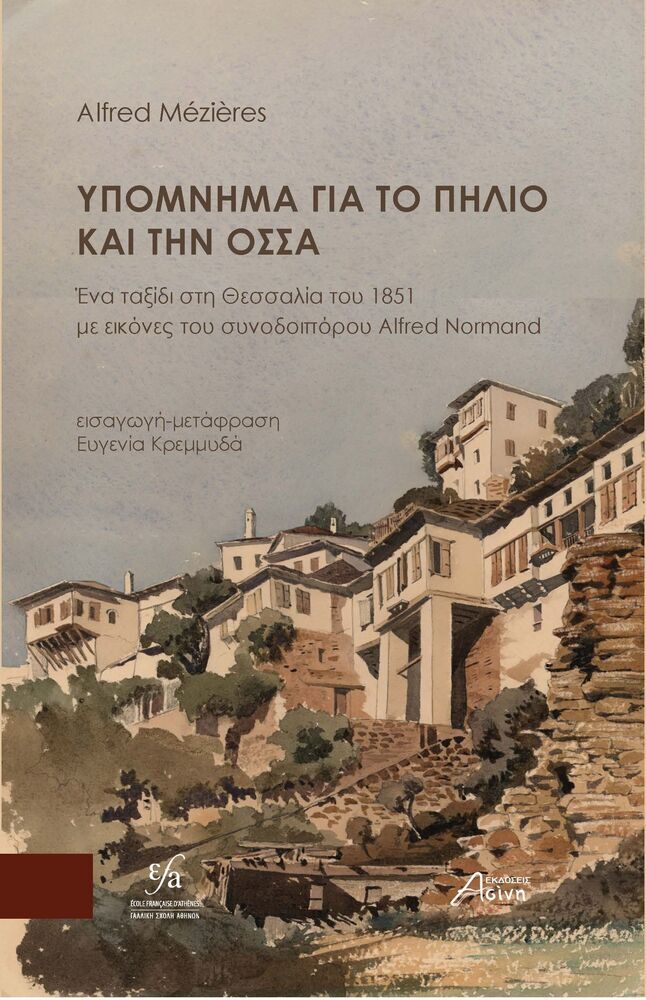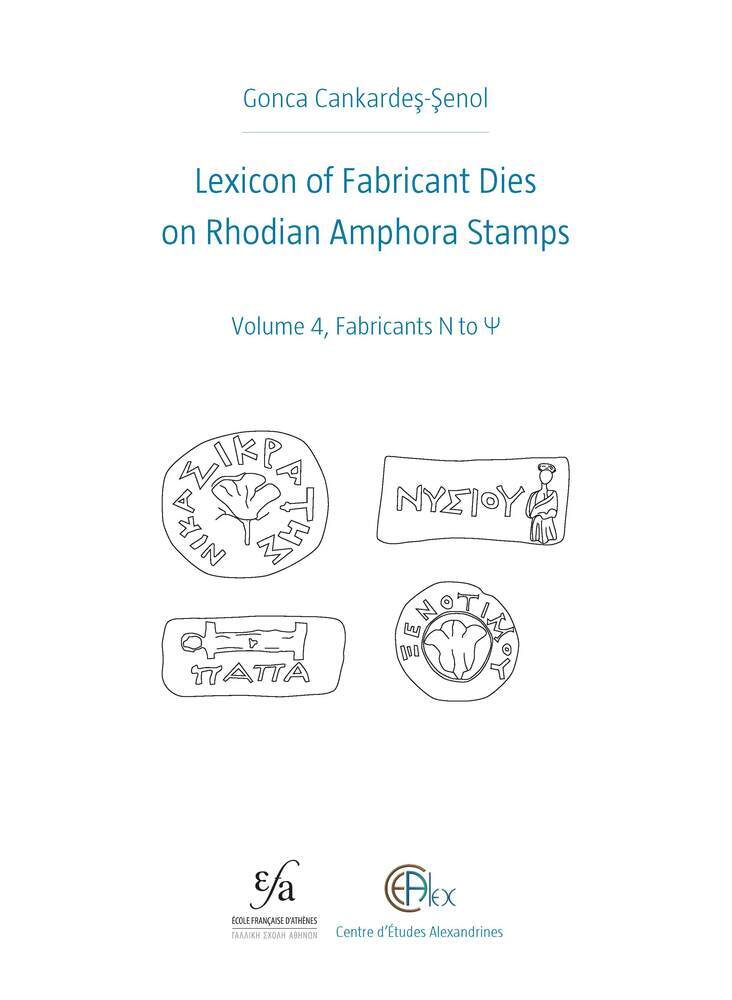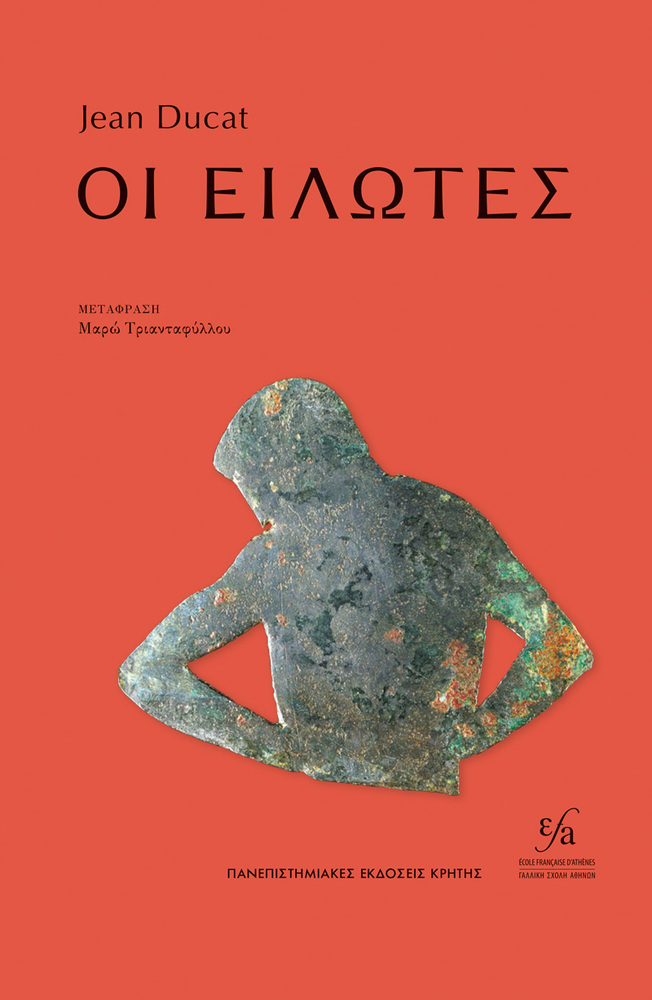Ancient Phokis
New approaches to its history, archaeology and topography
129 €
Collection et numéro : Et. med. 4
Année de parution : 2024
Éditeur(s) : Deutsche Archäologische Institut - Abteilung Athen,
École française d’Athènes
ISBN : 978-3-75200-825-8
Largeur : 21 cm
Hauteur : 29.7 cm
Nombre de pages : 525
Distributeurs : Reichert Verlag
Langues : Allemand, Français, Anglais
Supports : livre
This volume offers a comprehensive insight into ancient Phokis, a region in the heart of Greece. Its history was always shaped by the political and cultural influences of neighbouring powers. The diverse landscape provided space for the existence of numerous mostly small poleis. Thanks to its oracles in Delphi and Abai and the formation of a koinon, Phokis was closely integrated into supra-regional communication, trade and cultural networks. The book presents current research findings that offer a broad overview of the history and culture of the region and point to future research perspectives.
As a region in the heart of ancient Greece, Phokis was of central importance for transport and travel. Politically and culturally, it was thus often exposed to the interests and influences of neighbouring powers. The Phokian landscape is also diverse: from the bay of Antikyra on the Corinthian Gulf to the mighty massifs of Parnassos and Helikon, from the barren hills to the fertile river plain of Kephissos.
A considerable number of mostly small poleis shaped the political landscape. In Delphi and Abai (Kalapodi), two oracles exercised an early impact far beyond the borders of the country. This integrated Phokis into the supra-regional networks of communication, trade, politics, and cultural exchange. Under the pressure of more powerful neighbours, the Phokians came together in a koinon early on, already in the Archaic period. The ›Third Holy War‹ fought in and around Phokis around the middle of the 4th century B.C. ultimately led to the establishment of Macedon as a new hegemonic power, thus setting the course for a new epoch in Greek history. The koinon of the Phokian poleis remained influential in the political and social development of the countryside, albeit in a changed form and significance until well into the Imperial Period.
The tenth book of Pausanias gives a rich impression of the urban diversity, as well as the wealth of religious, mythological, and cultural traditions of Phokis. In the archaeologically tangible evidence on the ground, the image of Phokis today is dominated by numerous well-preserved, impressive fortifications set mainly on prominent hillsides. In contrast, residential buildings, public architecture and sanctuaries as well as necropoleis in the cities are only partially known. The systematic excavations in Delphi and Kalapodi, however, have provided rich and uniquely detailed insights into the history and material culture of these important sanctuaries.
A substantial amount of recent fieldwork is contributing significantly to expanding our picture of ancient Phokis. This volume of the International Conference held in Athens in 2017, jointly organised by the German Archaeological Institute and the École Française d'Athènes, brings together for the first time a cross-section of this current research: from the Iron Age to the Early Byzantine period. It tackles topics covering historical matters to settlement archaeology, sacred topography, material culture, and the architectural design of the sanctuaries; analyses of individual matters and broad material genres, and enquiries into aspects of a particular ›Phokian‹ identity. Thus, for the first time, a broad overview of the previous research tradition, desiderata, and new perspectives for future research into ancient Phokis is provided.
Distribution and commercialization by Reichert Verlag
As a region in the heart of ancient Greece, Phokis was of central importance for transport and travel. Politically and culturally, it was thus often exposed to the interests and influences of neighbouring powers. The Phokian landscape is also diverse: from the bay of Antikyra on the Corinthian Gulf to the mighty massifs of Parnassos and Helikon, from the barren hills to the fertile river plain of Kephissos.
A considerable number of mostly small poleis shaped the political landscape. In Delphi and Abai (Kalapodi), two oracles exercised an early impact far beyond the borders of the country. This integrated Phokis into the supra-regional networks of communication, trade, politics, and cultural exchange. Under the pressure of more powerful neighbours, the Phokians came together in a koinon early on, already in the Archaic period. The ›Third Holy War‹ fought in and around Phokis around the middle of the 4th century B.C. ultimately led to the establishment of Macedon as a new hegemonic power, thus setting the course for a new epoch in Greek history. The koinon of the Phokian poleis remained influential in the political and social development of the countryside, albeit in a changed form and significance until well into the Imperial Period.
The tenth book of Pausanias gives a rich impression of the urban diversity, as well as the wealth of religious, mythological, and cultural traditions of Phokis. In the archaeologically tangible evidence on the ground, the image of Phokis today is dominated by numerous well-preserved, impressive fortifications set mainly on prominent hillsides. In contrast, residential buildings, public architecture and sanctuaries as well as necropoleis in the cities are only partially known. The systematic excavations in Delphi and Kalapodi, however, have provided rich and uniquely detailed insights into the history and material culture of these important sanctuaries.
A substantial amount of recent fieldwork is contributing significantly to expanding our picture of ancient Phokis. This volume of the International Conference held in Athens in 2017, jointly organised by the German Archaeological Institute and the École Française d'Athènes, brings together for the first time a cross-section of this current research: from the Iron Age to the Early Byzantine period. It tackles topics covering historical matters to settlement archaeology, sacred topography, material culture, and the architectural design of the sanctuaries; analyses of individual matters and broad material genres, and enquiries into aspects of a particular ›Phokian‹ identity. Thus, for the first time, a broad overview of the previous research tradition, desiderata, and new perspectives for future research into ancient Phokis is provided.
Distribution and commercialization by Reichert Verlag
Dieser Band bietet einen umfassenden Einblick in das antike Phokis, eine Region im Herzen Griechenlands. Seine Geschichte war stets von politischen und kulturellen Einflüssen benachbarter Mächte geprägt. Die vielgestaltige Landschaft bot Raum für die Existenz zahlreicher meist kleiner Poleis. Dank seiner Orakel in Delphi und Abai sowie der Bildung eines Koinons war Phokis eng in überregionale Kommunikations-, Handels- und kulturelle Netzwerke eingebunden. Das Buch präsentiert aktuelle Forschungsergebnisse, die einen breiten Überblick über die Geschichte und Kultur der Region bieten und zukünftige Forschungsperspektiven aufzeigen.
Die Phokis ist eine Landschaft im Herzen des antiken Griechenland, von zentraler verkehrstechnischer Bedeutung und politisch wie kulturell vielfach den Interessen und Einflüssen benachbarter Mächte ausgesetzt. Vielgestaltig zeigt sich auch das phokische Landschaftsbild: von der Bucht von Antikyra am Korinthischen Golf über die mächtigen Massive von Parnassos und Helikon, karges Hügelland, bis zur fruchtbaren Flußebene des Kephissos.
Eine beachtliche Zahl zumeist kleiner Poleis prägte die politische Karte der Landschaft. Mit Delphi und Abai (Kalapodi) erlangten zwei Orakelheiligtümer hingegen schon früh Ausstrahlung weit über die Landesgrenzen hinaus und banden Phokis in die überregionalen Netzwerke von Kommunikation, Handel, Politik und kulturellem Austausch ein. Unter dem Druck mächtigerer Nachbarn fanden sich die Phoker schon früh, noch in archaischer Zeit, in einem koinon zusammen. Der um die Mitte des 4. Jhs. v. Chr. in und um Phokis ausgefochtene „Dritte Heilige Krieg“ führte letztlich zur Etablierung Makedoniens als neue Hegemonialmacht, und stellte damit die Weichen für eine neue Epoche der griechischen Geschichte. Das koinon der phokischen Städte blieb in wechselnder Gestalt und Bedeutung noch bis tief in die Kaiserzeit prägend für die politische und gesellschaftliche Entwicklung der Landschaft.
Von der städtebaulichen Vielfalt, dem Reichtum an religiösen, mythologischen und kulturellen Traditionen der Phokis vermittelt das X. Buch des Pausanias einen reichen Eindruck. Im archäologisch fassbaren Oberflächen-Befund dominieren heute die zumeist markant gelegenen Siedlungshügel mit ihren zahlreichen gut erhaltenen, eindrucksvollen Befestigungen das Bild von Phokis. Wohnbebauung, öffentliche Architektur und Heiligtümer sowie Nekropolen der Städte sind dagegen bislang eher ausschnitthaft bekannt. Die langjährigen systematischen Ausgrabungen in Delphi und Kalapodi ermöglichen hingegen reiche, und einmalig detaillierte Einblicke in die Geschichte und materielle Kultur bedeutender Heiligtümer.
Eine Vielzahl von neueren Feldforschungen trägt maßgeblich dazu bei, unser Bild der antiken Phokis zu erweitern. Der vorliegende Band der gemeinsam vom Deutschen Archäologischen Institut und der École française d'Athènes ausgerichteten Internationalen Konferenz von 2017 vereint erstmals einen Querschnitt dieser aktuellen Forschungen: von der Eisenzeit bis in frühbyzantinischen Zeit; von historischen zu siedlungsarchäologischen Fragestellungen; zur Sakraltopographie, der materiellen Kultur und architektonischen Gestaltung der Heiligtümer; von Analysen zu einzelnen Befund- und Materialgattungen; bis hin zu Aspekten einer spezifisch ‚phokischen‘ Identität. Damit wird zum ersten Mal auch ein breiter Überblick über die bisherige Forschungstradition, Desiderate und neue Perspektiven für künftige Forschung zur antiken Phokis ermöglicht.
Vertrieb und Vermarktung : Reichert Verlag
Die Phokis ist eine Landschaft im Herzen des antiken Griechenland, von zentraler verkehrstechnischer Bedeutung und politisch wie kulturell vielfach den Interessen und Einflüssen benachbarter Mächte ausgesetzt. Vielgestaltig zeigt sich auch das phokische Landschaftsbild: von der Bucht von Antikyra am Korinthischen Golf über die mächtigen Massive von Parnassos und Helikon, karges Hügelland, bis zur fruchtbaren Flußebene des Kephissos.
Eine beachtliche Zahl zumeist kleiner Poleis prägte die politische Karte der Landschaft. Mit Delphi und Abai (Kalapodi) erlangten zwei Orakelheiligtümer hingegen schon früh Ausstrahlung weit über die Landesgrenzen hinaus und banden Phokis in die überregionalen Netzwerke von Kommunikation, Handel, Politik und kulturellem Austausch ein. Unter dem Druck mächtigerer Nachbarn fanden sich die Phoker schon früh, noch in archaischer Zeit, in einem koinon zusammen. Der um die Mitte des 4. Jhs. v. Chr. in und um Phokis ausgefochtene „Dritte Heilige Krieg“ führte letztlich zur Etablierung Makedoniens als neue Hegemonialmacht, und stellte damit die Weichen für eine neue Epoche der griechischen Geschichte. Das koinon der phokischen Städte blieb in wechselnder Gestalt und Bedeutung noch bis tief in die Kaiserzeit prägend für die politische und gesellschaftliche Entwicklung der Landschaft.
Von der städtebaulichen Vielfalt, dem Reichtum an religiösen, mythologischen und kulturellen Traditionen der Phokis vermittelt das X. Buch des Pausanias einen reichen Eindruck. Im archäologisch fassbaren Oberflächen-Befund dominieren heute die zumeist markant gelegenen Siedlungshügel mit ihren zahlreichen gut erhaltenen, eindrucksvollen Befestigungen das Bild von Phokis. Wohnbebauung, öffentliche Architektur und Heiligtümer sowie Nekropolen der Städte sind dagegen bislang eher ausschnitthaft bekannt. Die langjährigen systematischen Ausgrabungen in Delphi und Kalapodi ermöglichen hingegen reiche, und einmalig detaillierte Einblicke in die Geschichte und materielle Kultur bedeutender Heiligtümer.
Eine Vielzahl von neueren Feldforschungen trägt maßgeblich dazu bei, unser Bild der antiken Phokis zu erweitern. Der vorliegende Band der gemeinsam vom Deutschen Archäologischen Institut und der École française d'Athènes ausgerichteten Internationalen Konferenz von 2017 vereint erstmals einen Querschnitt dieser aktuellen Forschungen: von der Eisenzeit bis in frühbyzantinischen Zeit; von historischen zu siedlungsarchäologischen Fragestellungen; zur Sakraltopographie, der materiellen Kultur und architektonischen Gestaltung der Heiligtümer; von Analysen zu einzelnen Befund- und Materialgattungen; bis hin zu Aspekten einer spezifisch ‚phokischen‘ Identität. Damit wird zum ersten Mal auch ein breiter Überblick über die bisherige Forschungstradition, Desiderate und neue Perspektiven für künftige Forschung zur antiken Phokis ermöglicht.
Vertrieb und Vermarktung : Reichert Verlag
Vorwort
Phocis, Delphoi, and the amphictyony, par Peter Londey 

Living on a rock. The cities of ancient Phocis and the importance of place, par Hans Beck 

Borders and identity in ancient Phocis: some reflections, par Giovanna Daverio Rocchi 

Phocis in the Aetolian League. Self-abandonment or self-assertion?, par Peter Funke 

The institutions of the Phocian League, par Denis Rousset 

Phocis in Roman times: beyond the shadow of Delphi, par Georgios A. Zachos
Das phokische Koinon zwischen Böotien, Delphi, Athen und Rom, par Christoph Begass 

Delphes et Kalapodi au début de l'âge du fer ancien (11e –9e siècles av. J. -C. ), par Jean-Marc Luce 

Zur Selbstdarstellung der Phoker in Delphi, par Anne Jacquemin 

Terres cuites figurées du dépôt votif de Kirrha: de l’établissement du matériel à son exploitation, par Stéphanie Huysecom-Haxhi 

The sanctuary of Athena in Phocian Antikyra, par Athanasios Sideris 

The fortifications of ancient Phocis :
Results and prospects, par Nicolas Kyriakidis 

Παναγίτσα Ελάτειας 1979–1981 :
Κτερίσματα και ταφικά έθιμα σε κλασσικό νεκροταφείο της Ελατείας, par Pántos A. Pántos 

Spanning two oracles The sanctuary of Demeter at Erochos, between Delphi and Abae, par Elena Partida  et Anthoula Tsaroucha
et Anthoula Tsaroucha
 et Anthoula Tsaroucha
et Anthoula Tsaroucha
The rediscovery of a manuscript by Erich Gose and Friedrich Schober on the Kephissos valley from 1926, par Katja Sporn 

Ο κρίσιμος 4ος αιώνας π.Χ.: παλαιές και νέες οχυρώσεις, παλαιοί και νέοι οικισμοί στην κοιλάδα του φωκικού Κηφισού, par Φώτης Ντάσιος
New research on the fortification of Tithorea. A preliminary report of fieldwork 2016–2017, par Petros Kounouklas et Eric Laufer 

Tαφές των Πρώιμων Αυτοκρατορικών Χρόνων από την Υάμπολη στην ανατολική Φωκίδα, par Maria Papageorgiou et Dimitris Grigoropoulos 

Sites of memory in ancient Phocis :
The Thessalian-Phocian battles , the Persian Wars, and the changing religious landscape, par Elena Franchi 

A transfer of sacred lands from eastern Phocis, IG IX1, 87, par Jeremy McInerney 

Kalapodi 2014–2016: Investigating the surroundings, limits and infrastructure of the sanctuary, par Katja Sporn 

Ritual burials of temples and ritual depositions accompanying building activities in the oracle sanctuary of Apollon at Abai/ Kalapodi, par Wolf-Dietrich Niemeier 

The bronze finds from the Late Geometric ›South Temple 6‹ at Kalapodi :
Cult practices and local craft traditions in eastern Phocis, par Gudrun Klebinder-Gauß 

The significance of the sanctuary of Kalapodi during the Archaic period based on the pottery finds, par Michaela Stark 

A palette of bronze and silver : the monetary perspective of the archaeological site at Kalapodi ., par Hristina Ivanova Anaplioti
New iron finds from the 2016 campaign in Kalapodi – Contexts and compositions, par Sandra Zipprich
A bronze foundry of Classical times in the sanctuary at Kalapodi, par Johanna Fuchs
Pagan twilight at Kalapodi : Two pottery assemblages of the third and fourth centuries A.D., par Dimitris Grigoropoulos 

Dans la même collection
Des mêmes auteurs
Diffuseur(s)
Reichert Verlag
11, Tauernstraße
D-65199 , Wiesbaden
Deutschland
+49 (0)611 946 59 11
Contact
Pour toute information - Πληροφορίες
École française d’Athènes
6, rue Didotou - 10680 Athènes
tel. +30 211 18 70 154









